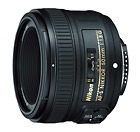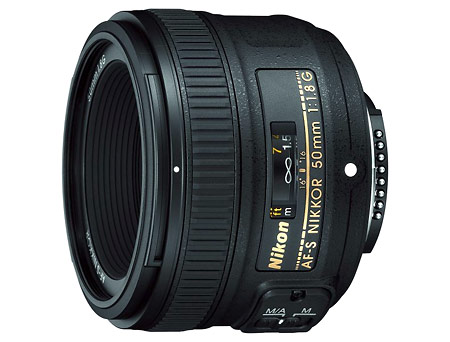 Nikon has a new “normal” 50mm lens, the AF-S Nikkor 50mm f/1.8G. I apologize to the Niko-philes reading this, but at first I wasn’t sure how this lens was different from the three other Nikon 50mm lenses. However, I did a little research and found that it is, in fact, different. The “G” designation is the key indicator here. It tells us that the lens doesn’t have an aperture ring and the aperture is controlled via the camera’s command dial. So the new 50mm f/1.8G lens won’t work old manual cameras that don’t have a command dial. Since most photographers these days are using recent digital SLRs, that’s not really much of a problem. If you are a film shooter holding on to an old Nikon with a name that starts with F or N, then you won’t be able to use the new AF-S Nikkor 50mm f/1.8G. I’d guess that it will be just fine for 90% of the Nikon photographers out there, though.
Nikon has a new “normal” 50mm lens, the AF-S Nikkor 50mm f/1.8G. I apologize to the Niko-philes reading this, but at first I wasn’t sure how this lens was different from the three other Nikon 50mm lenses. However, I did a little research and found that it is, in fact, different. The “G” designation is the key indicator here. It tells us that the lens doesn’t have an aperture ring and the aperture is controlled via the camera’s command dial. So the new 50mm f/1.8G lens won’t work old manual cameras that don’t have a command dial. Since most photographers these days are using recent digital SLRs, that’s not really much of a problem. If you are a film shooter holding on to an old Nikon with a name that starts with F or N, then you won’t be able to use the new AF-S Nikkor 50mm f/1.8G. I’d guess that it will be just fine for 90% of the Nikon photographers out there, though.
Why do you need a 50mm lens, you ask? Back in the olden days the lens most of us started with was a 50mm. That’s because on an FX format (full frame) SLR it has a “normal” field of view, similar to what the human eye perceives. On a DX format (APS-C crop sensor) camera, the 50mm lens is effectively converted into a 75mm lens – perfect for portraits. So whether you’re a full frame or APS-C DSLR owner, there’s a reason you should have a 50mm lens in your bag. The 50mm lens also comes in a small package so it’s easy to travel with or use unobtrusively. The fast f/1.8 aperture allows for great depth-of-field control for portraits or other subjects where you want to use a large aperture to make the background disappear. The 18-inch minimum focusing distance is nice, too.
So, to put the new Nikon 50mm f.1.8G in perspective, I made a spec table so you can compare to the other 50mm Nikkor lenses:
| Nikon AF-S 50mm f/1.8G | Nikon AF 50mm f/1.8D | Nikon AF 50mm f/1.4D | Nikon AF-S 50mm f/1.4G |
| $219.95 | $134.95 | $369.95 | $484.95 |
| f/1.8 – f/16 | f/1.8 – f/22 | f/1.4 – f/16 | f/1.8 – f/16 |
| 7 lens elements in 6 groups | 6 lens elements in 5 groups | 7 lens elements in 6 groups | 8 lens elements in 6 groups |
| 7 diaphragm blades | 7 diaphragm blades | 7 diaphragm blades | 9 diaphragm blades |
| 1.48 ft.(0.45m) min. focus | 1.5 ft.(0.45m) min. focus | 1.5 ft.(0.45m) min. focus | 1.5 ft.(0.45m) min. focus |
| 58mm filter | 52mm filter | 52mm filter | 58mm filter |
| 2.8 x 2.1 in. (72.1 x 52.4mm) | 2.5 x 1.5 in. (63.5 x 39mm) | 2.5 x 1.7 in. (64.5 x 42.5mm ) | 2.9 x 2.1 in. (73.5 x 54.2mm) |
| 6.6 oz. (185g) | 5.5 oz. (155g) | 8.1 oz. (230g) | 9.9 oz. (280g) |
The “estimated” retail price for the 50mm f/1.8G is $219. 95. That’s about $90 more than the 50mm f/1.8D lens so it won’t be the first choice for Nikon shooters on a budget. But it’s still a great value when you consider its versatility, the AF-S Silent Wave focusing motor and the better optics (7 lens elements in 6 groups vs. 6 elements in 5 groups for the 50mm f/1.8D). And it also costs over $100 less than the 50mm f/1.4D.
The new Nikon AF-S 50mm f/1.8G lens should be at authorized Nikon dealers in mid-June of 2011.

Nikon AF-S 50mm f/1.8G Lens Press Release >>
Related Content:
All Nikon User Reviews
All Lens User Reviews
Nikon Cameras Forum
Digital SLR Forum
All Nikon News & Articles
Nikon Web Site


I am really surprised by the price point. I love my old 50mm f1.8 D lens. I would definitely buy one of those used before shelling out the extra cash for the new G model.
You don’t think the new optics or the AF-S motor are worth the extra money, Brian?
I have the 50mm f1.8D. It’s fine but at apertures wider than f2.8 there is lower contrast and the definition drops especially in the corners. If the new optical formula makes the performance consistent even at the widest aperture (like most Nikon zoom lenses) then I’m interested.
I have the 35mm f1.8 AF-S and I like the ability to retouch the focus manually. With this sort of available-light lens I am usually working with limited depth of focus and it’s a plus that I don’t have with my current 50mm
I must say I don’t use the 50mm much with my DX format cameras (I prefer the 35mm and 85mm f1.8) but if I went back to FX format then a 50mm is a must
I already have the AF 50mm D f/1.4, which one should i stand for?